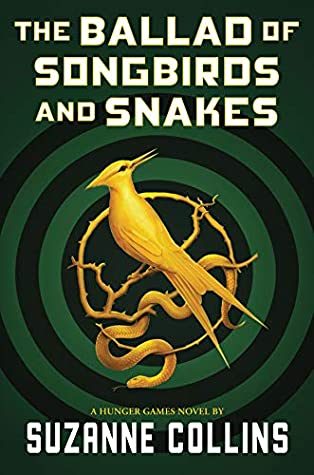
One in a series of reviews contributed by Chancellor Dwight C. Watson
The Ballad of Songbirds and Snakes by Suzanne Collins
Katniss Everdeen is the main protagonist and the narrator of The Hunger Games trilogy. After her younger sister, Primrose, was reaped to participate in the 74th Hunger Games, Katniss volunteered to take her place as the female tribute from District 12. This action set in motion the events of the entire series. Now flashback 64 years before that time and imagine the 10th Hunger Games when Coriolanus Snow, the dictatorial president of the fictional nation of Panem, was only 18.
The Ballad of Songbirds and Snakes captures Coriolanus’ coming of age story 64 years prior to the Katniss Everdeen’s entry into the games. The story unfolds the beginnings of Coriolanus striving and surviving in lean times after the ravages of the war between the Capital and the other districts. It is the morning of the reaping that will kick off the 10th Annual Hunger Games. In the Capital, Coriolanus Snow, as a mentor in the games, is preparing for a shot at redemption and the saving of the House of Snow’s pride and dignity. The once-mighty Snow name was severely damaged after the death of Coriolanus’ father in the war and the house has fallen on hard times. The Snow legacy is hanging on the slender chance that Coriolanus will be able to out charm, outwit, and outmaneuver his fellow students to mentor the winning tribute.
The odds are against Coriolanus. He has been given the humiliating assignment of mentoring the female tribute from District 12, Lucy Gray Baird, the lowest of the low. District 12 is the most impoverished and has limited resources, and to have a female tribute makes the odds more problematic, especially for a person like Lucy Gray who is more of an entertainer than a warrior. Regardless, Coriolanus and Lucy’s fates are now completely intertwined. The choices Coriolanus makes could lead to favor or failure, triumph or ruin. Inside the arena, it will be a fight to the death. Outside the arena, Coriolanus starts to feel for his doomed tribute and must weigh his need to follow the rules against his desire to survive, no matter what it takes.
As I read this book, I was captivated once again by the visual language of Stephanie Collins. She is a literary genius as she transports you into a dystopian world of sights, sounds, and tastes. The reader becomes captivated by the pageantry, technology, and horror of the workings of the Capital and the spectacle of the Hunger Games. When I first read The Hunger Games and the other two books in the trilogy – Catching Fire and Mockingjay, I remembered the giddy fascination of sensory overload and the bewitching allure of the arena while gasping at the cunning, strategies, and wickedness of the tributes. I picked up this book hungry for the taste of The Hunger Games and the succulence of Collin’s visualizations and storytelling.
Alas, the 10th Annual Hunger Games is far different from the pageantry and valor of the 75th Hunger Games. The 10th games are stark, gritty, and animalistic. The tributes are kept in cages in the zoo, given no respect, and the games are barely watched or televised in the districts besides Reaping Day when the tributes are selected. The tributes are not prized and betted on as champions, but are dismissed as simply sacrifices — spoils of war. In this version of the Hunger Games, the reader recognizes that humanity is unforgiving and regular people can easily transcend into monstrous, murderous beasts simply for food and survival. The hard questions are what kind of future do humans want and what are they willing to do to get it?
If the reader is a fan of young adult dystopian literature, then be prepared to be fascinated with this origin story. But if a fan of the Hunger Games series, the reader might think this prequel is a bit lackluster and too long. The book does end in a mystery that baits the reader to await the next chapter that leads to the 74th Hunger Games that started the original trilogy. This was a very entertaining read which took me back to my love of children’s and young adult literature.
A note from the Education Librarian:
Explore the ways in which The Hunger Games has found its way into literature criticism, social analysis, and other disciplines.
Diversity Issues:
- The Dark Fantastic: Race and the Imagination from Harry Potter to The Hunger Games / Ebony Elizabeth Thomas.
- Hunting Girls: Sexual Violence from The Hunger Games to Campus Rape / Kelly Oliver.
Philosophy: The Hunger Games and Philosophy a Critique of Pure Treason / edited by George A. Dunn and Nicolas Michaud.
Economics: Of Bread, Blood, and The Hunger Games: Critical Essays on the Suzanne Collins Trilogy / edited by Mary F. Pharr and Leisa A. Clark.
Literary criticism:
- Approaching the Hunger Games Trilogy: A Literary and Cultural Analysis / Tom Henthorne.
- Space and Place in the Hunger Games: New Readings of the Novels / edited by Deidre Anne Evans Garriott, Whitney Elaine Jones and Julie Elizabeth Tyler.
Literary criticism with an eye on the environment:
- Fire and Snow: Climate Fiction from the Inklings to Game of Thrones / Marc DiPaolo.
- Beasts at Bedtime: Revealing the Environmental Wisdom in Children’s Literature / Liam Heneghan.
For Hunger Games fans who just cannot get enough:
- Katniss the Cattail: An Unauthorized Guide to Names and Symbols in Suzanne Collins’ The Hunger Games / Valerie Estelle Frankel.
- The Hunger Games: The Official Illustrated Movie Companion / by Kate Egan.
